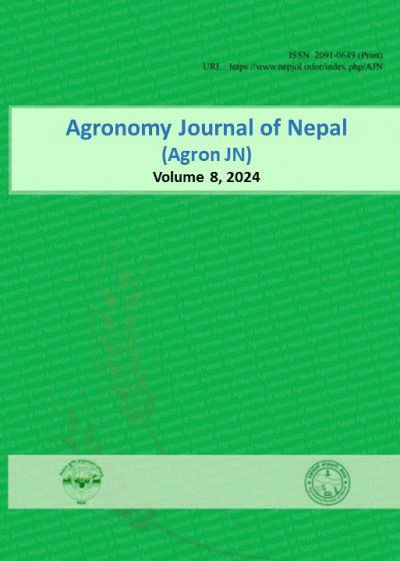Effect of Different Weed Management Practices on growth and yield in Potato at Khumaltar, Lalitpur, Nepal
DOI:
https://doi.org/10.3126/ajn.v8i1.70787Keywords:
Critical- period, metribuzin, micro-climate, mulch, yieldAbstract
Potato (Solanum tuberosum L.) is the fifth most important crops in the world in terms of production with an estimate of 375 million metric tons. In Nepal, potato ranks second in terms of production and sixth in terms of area coverage. Potato production is affected by weed infestation. Weeds compete with crops for nutrients, water and other resources, which eventually reduce the crop yield. The critical period of crop-weed competition for potato is 25-40 days from planting depending on the climatic-zone and planting seasons. The most common method of weed control in Nepal is manual method, while herbicides are uses in less areas. Weeds are considered as the major problem in conventional and organic farming, due to lower yields by weeds and higher costs of labor for weed control. Mulching is one of the best and safest practice for effective weed management in potato due to which micro-climate manipulation is developed. Metribuzin is widely used herbicides in potato that controls a range of broadleaf weed species and suppresses many grassy weeds. To study the performance of different weed management practices in potato ten treatments were set up viz., three herbicides (pendimethalin@ 1.0 kg a.i ha-1, metribuzin@ 0.5 kg a.i ha-1 and atrazine @ 0.25 kg a.i ha-1) constituting seven treatments, one mulching with rice straw, one treatment with two manual hoeing, and another treatment with no any weed management practices as control.The treatments were laid out in RCB design with 4 replications. The potato variety Janak Dev was planted on 12th Feb 2021 and 23rd Jan 2022 with tuber rate of 4.1 t.ha-1 with row spacing of 60 cm and plant to plant 20 cm in a plot size of 4 x 3 meter in flat bed. Growth parameters such as plant height, plant fresh and dry biomass were recorded. Data on weed density, weed dry biomass, and tuber yield were taken.The economics of the different treatments were calculated. Among the treatments metribuzin@ 0.25 kg a.i ha-1 as pre-emergence proved effective in controlling weeds showing highest weed control efficiency (200.7 %) and tuber yield (32.79 t ha-1) . However, the treatment rice straw mulch @ 6 t ha-1 produced the highest tuber yield (38.31 t ha-1), 73.4 % increased yield over control, weed control efficiency(147.1%), economic benefit (NRS 13,40,850), benefit cost ratio (4.93).The treatment rice straw mulch @ 6 t ha-1 showed superiority among the different weeds management practices.
Downloads
Downloads
Published
How to Cite
Issue
Section
License
Copyright (c) 2024 Agronomy Society of Nepal (ASoN)

This work is licensed under a Creative Commons Attribution-NonCommercial 4.0 International License.
ASON permits for free use, distribution and reproduction in any medium if the original work is properly cited and not used for commercial purposes.




